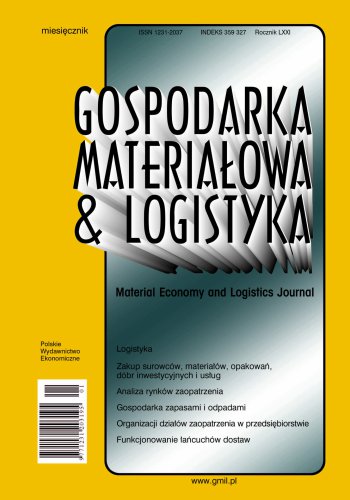Neutralization of industrial liquid waste in laboratory conditions
The fast development of technology and modern branches of industry is conducive to the increase in the amount of generated waste. This is associated with serious ecological and economic problems that must be controlled and solved on an ongoing basis in accordance with the requirements of environmental protection. Early recognition of the threat posed by inappropriate waste management allows to make the right decisions in a short time, which will be safe, acceptable to society and probably associated with much lower costs. Action is needed both by producers and citizens, aimed at developing effective methods of waste disposal. This paper attempts to analyze and explain the issues related to the thermal neutralization of combustible industrial waste. The purpose of the study was to use the abovementioned wastes primarily for energy purposes. This procedure can be applied to various already existing technological processes. Thermal utilization takes place in various types of chambers, and the installations are selected individually for each type of waste due to the variety of their properties.
References
Bibliografia/References
Bala-Litwiniak, A. (2021). Environmental and economic aspects of combustion of biomass pellets containing a waste glycerol. Combustion Science and Technology, 193(11), 1998–2008. https://doi.org/10.1080/00102202.2020.1746774
Bala-Litwiniak, A., Radomiak, H. (2016). Environmental benefits of co-combustion of light fuel oil with waste glycerol. Energy Sources, Part A: Recovery, Utilization and Environmental Effects, 38(17), 2510–2516. https://doi.org/10.1080/15567036.2015.1091867
Da Silva, L. J., Alves, F. C., De França, F. P. (2012). A review of the technological solutions for the treatment of oily sludges from petroleum refineries. Waste Management and Research, 30(10), 1016–1030. https://doi.org/10.1177/0734242X12448517
Glushkov, D. O., Feoktistov, D. V., Kuznetsov, G. V., Batishcheva, K. A., Kudelova, T., Paushkina, K. K. (2020). Conditions and characteristics of droplets breakup for industrial waste-derived fuel suspensions ignited in high-temperature air. Fuel, 265 (April). https: //doi.org/10.1016/j.fuel.2019.116915
Marculescu, C. (2012). Comparative analysis on waste to energy conversion chains using thermal-chemical processes. Energy Procedia, 18, 604–611. https://doi.org/10.1016/j.egypro.2012.05.073
Minister Gospodarki (2015). Rozporządzenie Ministra Gospodarki z dnia 5 października 2015 r. w sprawie szczegółowego sposobu postępowania z olejami odpadowymi. https://isap.sejm.gov.pl/isap.nsf/DocDetails.xsp?id=WDU20150001694 (30.09.2021).
Musiał, D. (2020). Coke and blast furnace gases: ecological and economic benefits of use in heating furnaces. Combustion Science and Technology, 192(6), 1015–1027. https://doi.org/10.1080/00102202.2019.1605990
Musiał, D. (2021). Optimization of the coke oven gas combustion process in an experimental heating chamber. Przemysł Chemiczny, 100(4), 347–349. https://doi.org/10.15199/62.2021.4.5
Musiał, D., Radomiak, H., Zajemska, M., Wyleciał, T. (2015). Ekonomiczno-ekologiczny aspekt energetycznego wykorzystania wybranych nośników energii. Logistyka, 6, 288–291.
Parlament Europejski (2008). Dyrektywa Parlamentu Europejskiego i Rady 2008/98/WE z dnia 19 listopada 2008 r. w sprawie odpadów oraz uchylająca niektóre dyrektywy.
Rada Ministrów (2012). Ustawa z dnia 14 grudnia 2012 r. o odpadach. https://isap.sejm.gov.pl/isap.nsf/DocDetails.xsp?id=WDU-20130000021 (30.09.2021).
Rada Ministrów (2016). Uchwała Nr 88 Rady Ministrów z dnia 1 lipca 2016 r. w sprawie Krajowego planu gospodarki odpadami 2022. http://isap.sejm.gov.pl/isap.nsf/DocDetails.xsp?id=WMP20160000784 (30.09.2021).
Rada Ministrów (2021). Uchwała nr 57 Rady Ministrów z dnia 6 maja 2021 r. zmieniająca uchwałę w sprawie Krajowego planu gospodarki odpadami. https://bip.mos.gov.pl/strategie-plany-programy/krajowy-plan-gospodarki-odpadami/uchwala-nr-57-rady-ministrowz-dnia-6-maja-2021-r-zmieniajaca-uchwale-w-sprawie-krajowego-planu-gospodarki-odpadami-2022 (30.09.2021)
Stapf, D., Ciceri, G., Johansson, I. (2020). Trends and drivers in alternative thermal conversion of waste (September). IEA Bioenergy: Task 36.
Wang, X., Li, C., Lam, C. H., Subramanian, K., Qin, Z. -H., Mou, J. -H., Jin, M., Chopra, S. S., Singh, V., Ok, Y. S., Yan, J., Li, H. -Y., Lin, C. S. K. (2022). Emerging waste valorisation techniques to moderate the hazardous impacts, and their path towards sustainability. Journal of Hazardous Materials, 423, 127023. https://doi.org/10.1016/j.jhazmat.2021.127023
Xue, Y., Zhou, S., Brown, R. C., Kelkar, A., Bai, X. (2015). Fast pyrolysis of biomass and waste plastic in a fluidized bed reactor. Fuel, 156, 40–46. https://doi.org/10.1016/j.fuel.2015.04.033

